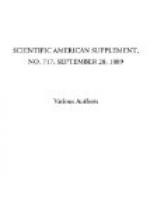The smaller waves are, however, far the most interesting and the most tractable to ordinary optical experiments. From a small oscillator, which may be a couple of small cylinders kept sparking into each other end to end by an induction coil, waves are emitted on which all manner of optical experiments can be performed.
They can be reflected by plain sheets of metal, concentrated by parabolic reflectors, refracted by prisms, concentrated by lenses. I have at the college a large lens of pitch, weighing over three hundredweight, for concentrating them to a focus. They can be made to show the phenomenon of interference, and thus have their wave length accurately measured. They are stopped by all conductors and transmitted by all insulators. Metals are opaque, but even imperfect insulators such as wood or stone are strikingly transparent, and waves may be received in one room from a source in another, the door between the two being shut.
The real nature of metallic opacity and of transparency has long been clear in Maxwell’s theory of light, and these electrically produced waves only illustrate and bring home the well known facts. The experiments of Hertz are in fact the apotheosis of that theory.
Thus, then, in every way Maxwell’s 1865 brilliant perception of the real nature of light is abundantly justified; and for the first time we have a true theory of light, no longer based upon analogy with sound, nor upon a hypothetical jelly or elastic solid.
Light is an electro-magnetic disturbance of the ether. Optics is a branch of electricity. Outstanding problems in optics are being rapidly solved now that we have the means of definitely exciting light with a full perception of what we are doing and of the precise mode of its vibration.
It remains to find out how to shorten down the waves—to hurry up the vibration until the light becomes visible. Nothing is wanted but quicker modes of vibrations. Smaller oscillators must be used—very much smaller—oscillators not much bigger than molecules. In all probability—one may almost say certainly—ordinary light is the result of electric oscillation in the molecules of hot bodies, or sometimes of bodies not hot—as in the phenomenon of phosphorescence.
The direct generation of visible light by electric means, so soon as we have learnt how to attain the necessary frequency of vibration, will have most important practical consequences.
Speaking in this university, it is happily quite unnecessary for me to bespeak interest in a subject by any reference to possible practical applications. But any practical application of what I have dealt with this evening is apparently so far distant as to be free from any sordid gloss of competition and company promotion, and is interesting in itself as a matter of pure science.
For consider our present methods of making artificial light; they are both wasteful and ineffective.




